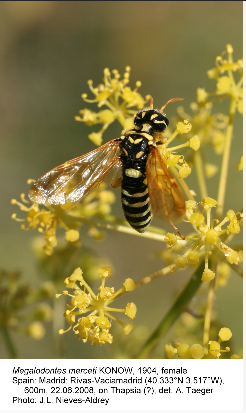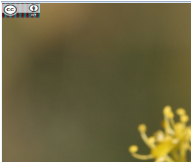esare Bellini from EDINA and I are doing a developer challenge, adapting my hack4ac prototype to annotate images with licence information. See /pmr/2013/07/24/making-images-open-can-and-should-be-routine/ for the idea. What we are going to do is:
- Point to a URL of an image (we’ll use Figshare for the demo, but it could be any CC-BY/CC0 image, so BMC, PLoS, etc.
- Upload a licence image (we can customise this for any author)
- Add the licence PIXELS to the image
- Save to file
I shall demo with a local implementation and Cesare is building it on a server.
We take an image, such as in http://figshare.com/articles/Megalodontes_merceti_on_a_flower_Spain_Rivas_Vaciamadrid_/761200:

[Note this is REALLY exciting for Ross Mounce and me working on biodiversity].
We then take a CC licence. Here I’ll use CC-BY:

And then we add this to the image and save locally (truncated…):

This has added the licence INTO the pixels. No-one can remove it (without it being obvious). It’s rendered in print. For ever.
If SpringerImages and their glitch ever “copyrights” it for Springer we can always point to the licence.
The code is trivial. Literally 10 lines of Java (it took me ca 1 hour to find my way around).
Cesare hopes to customize this on a server and we might even have something working that YOU can try by the end of the day.
Peter, most image management programs have this kind of “watermarking”; the photogrpher will usually include his/her name, (C) symbol as appropriate, and/or website. Often these are semi-transparent so as to have less visual impact on the image. I’m not saying this is a bad idea at all, as the processes to achieve this can be obscure, and not obvious to the casual/occasional user. Having this as a single-function tool sees to me a good idea, but suggest the option to add attribution info and variable transparency too.
Chris
Thanks Chris,
>>Peter, most image management programs have this kind of “watermarking”; the photogrpher will usually include his/her name, (C) symbol as appropriate, and/or website. Often these are semi-transparent so as to have less visual impact on the image. I’m not saying this is a bad idea at all, as the processes to achieve this can be obscure, and not obvious to the casual/occasional user. Having this as a single-function tool sees to me a good idea, but suggest the option to add attribution info and variable transparency too.
The key thing is to add CC licences…
Chris Gutteridge built on this idea and added a plugin for EPrints. This is a MUCH higher quality tool than the one I have shown here. ChrisG does transparency and adds name down the RHS. Looks promising
Chris
Pingback: Repository Fringe 2013: Reports from the Blogosphere | Repository Fringe 2013